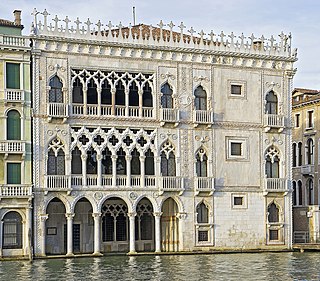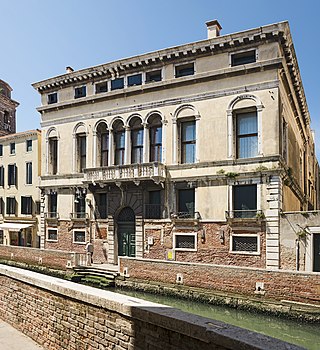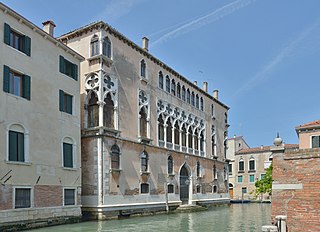
The Doge's Palace is a palace built in Venetian Gothic style, and one of the main landmarks of the city of Venice in northern Italy. The palace was the residence of the Doge of Venice, the supreme authority of the former Republic of Venice. It was built in 1340 and extended and modified in the following centuries. It became a museum in 1923 and is one of the 11 museums run by the Fondazione Musei Civici di Venezia.

The Grand Canal is a channel in Venice, Italy. It forms one of the major water-traffic corridors in the city.

The Ca' d'Oro or Palazzo Santa Sofia is a palace on the Grand Canal in Venice, northern Italy. One of the older palaces in the city, its name means "golden house" due to the gilt and polychrome external decorations which once adorned its walls. Since 1927, it has been used as a museum, as the Galleria Giorgio Franchetti.

Ca' Rezzonico is a palazzo and art museum on the Grand Canal in the Dorsoduro sestiere of Venice, Italy. It is a particularly notable example of the 18th century Venetian baroque and rococo architecture and interior decoration, and displays paintings by the leading Venetian painters of the period, including Francesco Guardi and Giambattista Tiepolo. It is a public museum dedicated to 18th-century Venice and one of the 11 venues managed by the Fondazione Musei Civici di Venezia.
Francesco da Mosto is an Italian architect, author, historian, film maker and television presenter. He presented the three BBC 2 series Francesco's Venice (2004) and Francesco's Italy: Top to Toe (2006) where he explored the country in an Alfa Romeo Spider and Francesco's Mediterranean Voyage which sees him sailing aboard the Camper and Nicholsons ketch Black Swan from his home city, Venice, to Istanbul, visiting places including Split, Mostar and Dubrovnik. He presented the two part BBC 2 series: Shakespeare in Italy, (2012).

The House of Loredan is a Venetian noble family of supposed ancient Roman origin, which has played a significant role in shaping the history of the entire Mediterranean. A political dynasty, the family has throughout the centuries produced a number of famous personalities: doges, statesmen, magnates, financiers, diplomats, procurators, military commanders, naval captains, church dignitaries, writers, and lawyers.

The office of Procurator of Saint Mark was one of the few lifetime appointments in the government of the Venetian Republic and was considered second only to that of the doge in prestige. It was routinely occupied by nobles belonging to the most influential families and typically represented the climax of a distinguished political career, although it was often an intermediate position prior to election as doge.

The Palazzo Barbarigo Minotto is a 15th-century palace on the Grand Canal in Venice, northern Italy, next to the much larger Palazzo Corner. Built in the Venetian Gothic style, it was originally two palaces, Palazzo Barbarigo and Palazzo Minotto, later joined together. The Barbarigo palace was owned by the Barbarigo family for several centuries and was the birthplace of Gregorio Barbarigo, who once refused the Papal Crown. It was later owned by the Minotto and Martinengo families.

Ca' Farsetti is a palace in Venice, Italy. It is located in the sestiere (district) of San Marco, and faces the Grand Canal, not far from the Ponte di Rialto. The neighboring building is Palazzo Cavalli.

The Palazzo Corner Spinelli is a palace in Venice, northern Italy, located on the Grand Canal, in the sestiere of San Marco. It stands across the canal from the Palazzo Querini Dubois.

The Palazzo Clary is a Late Renaissance Venetian palace facing the Giudecca Canal alongside the fondamenta Zattere by the ponte longo in Venice's Dorsoduro. It was originally built in the 17th century for a Venetian noble family. In the early 19th century, the palazzo is known as Palazzo Clary, named after it was bought by the prince Clary-Aldringen. The neighboring building is Palazzo Giustinian Recanati.

Ca Bembo is a grade-listed sixteenth-century palazzo in the parish of San Trovaso in the sestiere of Dorsoduro in Venice, Italy, noteworthy for a particularly large garden. It has, despite its name, no clear connection with the Bembo family, but a particularly strong association with one of the most prominent branches of the aristocratic Venetian family of the Barbarigo.

The Palazzo Ferro Fini is a historical building in Venice, Italy. It was originally two buildings, the Palazzo Morosini Ferro and the Palazzo Flangini Fini, which were combined into one in the 1860s to create the luxury Hotel New York. The hotel was occupied by troops in World War II (1939–45). By 1970 the hotel was in decay, and the building was purchased by the Veneto region, which undertook extensive renovations and made it the seat of the regional council.
Ca’ Sanudo Turloni is a Gothic-style palace located with a façade on Rio de Sant'Antonio, and located in Calle Pezzana #2162, in the Sestiere San Polo in Venice, Italy.

The Palazzo Papadopoli is a Baroque-style palace located on the Canal Grande of Venice, between Palazzo Giustinian Businello and Palazzo Donà a Sant'Aponal in the Sestiere of San Polo, Venice, Italy. The opposite building is the Palazzo Corner Contarini dei Cavalli.

Palazzo Correr Contarini Zorzi is a Renaissance palace in Venice, Italy, overlooking the Grand Canal and locating in the Cannaregio district between Palazzo Querini Papozze and Palazzo Gritti. The palazzo is also known as Ca' dei Cuori, a family whose wrought iron coats of arms is present on the façade.

Palazzo Giovanelli is a palace in Venice, located in the Santa Croce district, overlooking the right side of the Grand Canal and the Rio di San Giovanni Decollato, before the Fondaco dei Turchi.

Palazzo D'Anna Viaro Martinengo Volpi di Misurata, also known as Palazzo Talenti D'Anna Volpi, is a Renaissance palace in Venice, Italy, located in the San Marco district, overlooking the left side of the Grand Canal, between Palazzo Tron and Casa Marinoni and opposite of Palazzo Donà a Sant'Aponal.

Palazzo Donà Giovannelli is a civil building located in the city of Venice, Italy in the Cannaregio district. The palace neighbors Palazzo Pasqualigo Giovannelli and overlooks the Rio di Noale and the Rio di Santa Fosca.

Palazzo Falier is a civil building located in Venice, Italy in the Cannaregio district. The palazzo is particularly known for having been the home of Marin Falier, Doge of the Republic of Venice, who was executed for attempting a coup d'état.





















